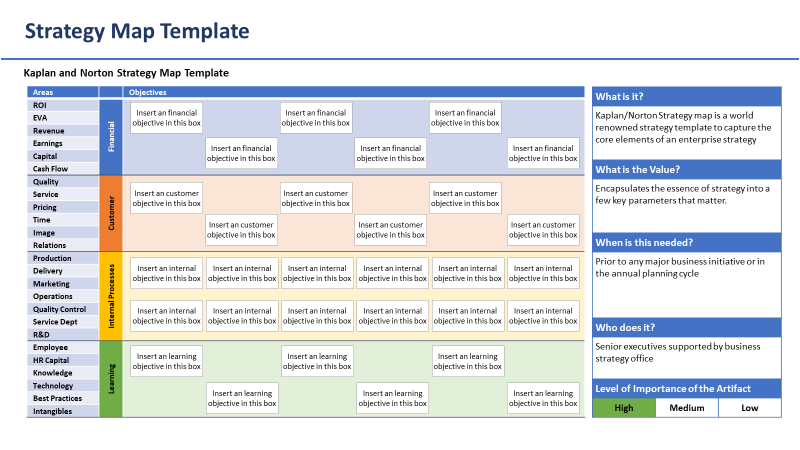What are Strategy Maps?
Strategy Maps visually represent an organization’s corporate strategy and the specific processes, systems, linkages, and relationships that help implement a strategy on a single page.
Popularized by Robert S. Kaplan and David P. Norton, a strategy map shows how organizations turn intangible assets and corporate resources into profitable real-world outcomes. In addition, it provides a common framework and language for describing the critical steps in implementing an effective corporate strategy that boosts survivability.
A strategy map (SM) is a versatile, battle-tested tool. It provides a visual representation of an organization’s business strategy and the specific processes, systems, linkages, and relationships the company uses to implement it—all drawn on a single page. Put another way. An SM shows how a company turns assets and resources into real-world outcomes that boost profitability.
Benefits of a Strategy Map
While strategy maps aren’t perfect, they can generate dramatic results when implemented correctly. Benefits include:
- Maximize value with innovative new growth
- Streamline operations; minimize cost and complexity
- Maximize value to customers through the core offer
- Enhance customer experiences
- Deliver world-class shareholder returns
Organizations must change to survive long-term. Strategy maps describe how an organization will change.
Strategy Mapping – Situation and Use Cases
Strategy maps are used in insurance, banking, retail, telecom, non-profits, and government units. They can be used to depict:
- High-level strategy effectively to employees
- Objectives for revenue growth
- Target markets in which profitable growth will occur
Value propositions that boost businesses
- Investments in people/systems needed to generate growth
- How organizations convert their resources into tangible outcomes
Strategy maps have been developed for large multi-national companies and small businesses with as few as 25 employees.
Practical Applications of Strategy Maps
Strategy maps also help translate strategy into operational terms, align people with actions, and put a value on things often hard to measure:
- Royal Canadian Mounted Police mapping of job in Article Circle
- Boston Lyric Opera used a strategy map to boost effectiveness with customers
- Mobil North American Marketing and Refining turnaround generated by mapping
- Ingersoll Rand uses a strategy map to align multiple business units
- Volvofinan used the map to communicate high-level strategy effectively and compellingly to all employees
Strategy maps extend the Balanced Scorecard (BS) measurement system— a more rigorous and detailed approach to measuring and managing performance.
Alternatives and Limitations
Strategy maps don’t work when direct cause and effect relationships are clear of don’t even exist; when establishing an idealistic future state with set objectives; when the future might realistically include unknowable and unimaginable events like Black Swans and Serendipity; and when using past measures, and current standards could hamper the emergence of totally different metrics. Creating a business model is an alternative to creating a strategy map.
Applying Strategy Maps
The best way to create a strategy map is from the top down. Ideally, managers should first review the enterprise’s mission statement and core values before making a map. Next, the review will explain why the company exists.
Having determined why the business exists, managers can then develop the company’s strategic vision. This vision should provide a clear picture of the company’s fundamental goal. Managers can then determine the map’s objective and chart the business “routes” that will lead there before creating a map.
Here are specific steps to follow when creating a strategy map:
- Choose a value proposition
- Create a key objective
- Select a financial strategy
- Choose a customer strategy
- Choose an internal perspective
- Select a growth strategy
Once a strategy map is developed, managers can then use the map as the foundation of a strategic management system that helps the organization grow effectively and rapidly.
Tips for creating strategy maps
- Concentrate on getting the objective(s) right when developing a strategy map and forget about measures.
- Don’t shortcut the strategy map creation process. It’s more a matter of conversation and exploration within management teams than anything else.
- Use a vertical strategic theme that crosses existing perspectives. For example, leave off any views that destroy the cause-and-effect relationship.
- Never copy a strategy map to another company. Instead, a company needs to create its strategy map.
- Strategy maps need to be created by management teams. This approach helps generate ownership within the team.
- Strategy maps are operational maps. Avoid getting too detailed in them. Instead, make strategic choices and focus priorities.
- It would help if you read your business model, the customer’s business model, how the company delivers value to customers, and how it intends to change to do it on the map.
Strategy Maps overview is a part of Stratrix.com’s coverage of Classic Management Frameworks.


